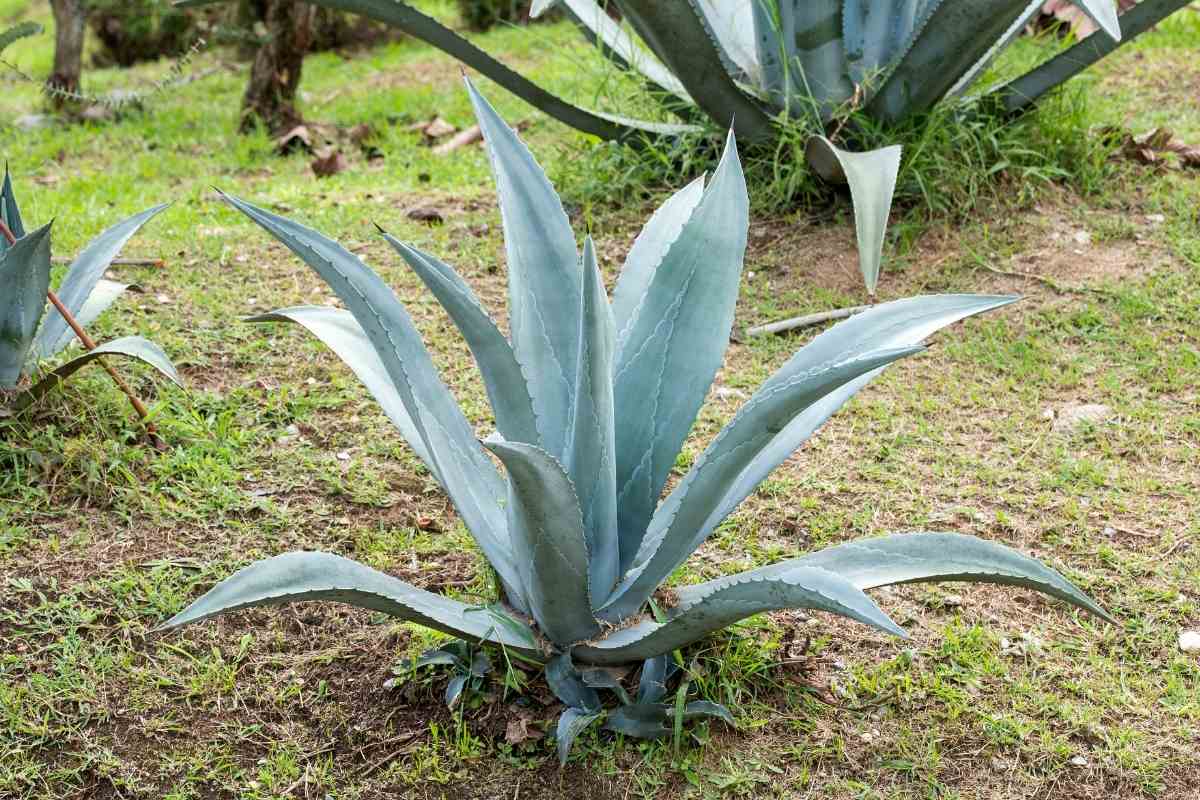Agaves are among the most popular succulents grown in homes and offices because of their beautiful, dramatic foliage.
They require little maintenance to thrive and can withstand extreme conditions, such as frost and a scorching sun.
On the downside, agaves are monocarpic, blooming once in their lifetime.
Blue agave (Agave tequilana azul) is an attractive garden plant used to make tequila.
It grows up to six feet tall and produces vibrant yellow flowers between its sixth and eighth birthdays.
Here’s more info on growing the blue agave plant.
Propagating Agave
Most agaves propagate themselves through seeds or pups.
Propagation from Pups
Mature plants produce pups that run underground and grow sprouts. These pups form independent root systems, making them ideal for transplanting.
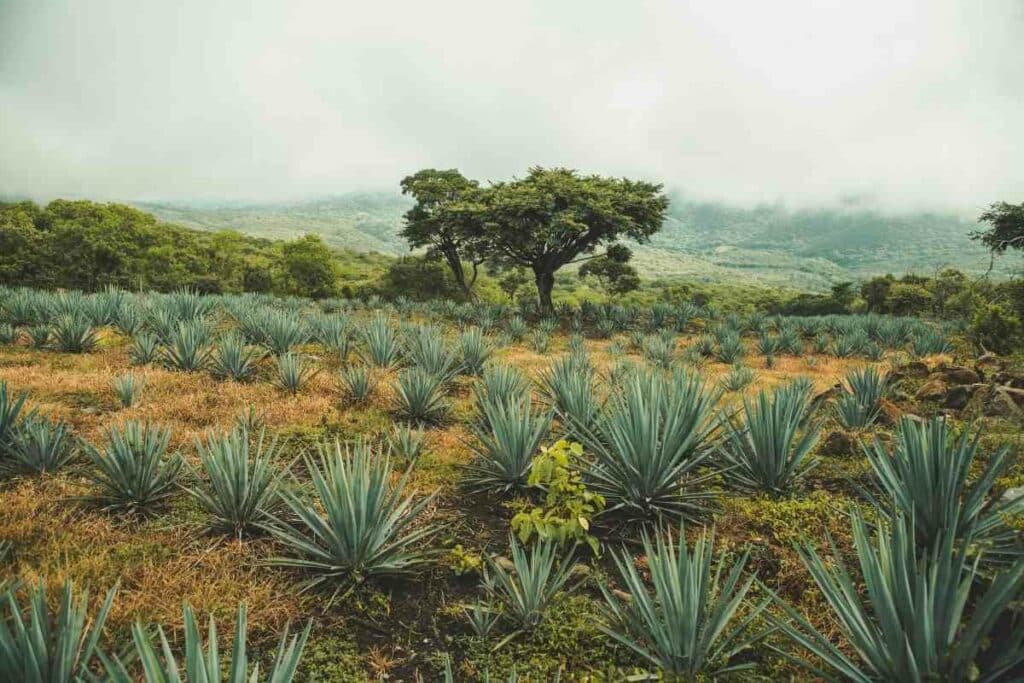
The pups are ready to transplant once they have at least two leaves.
When handling agaves:
- Wear thick gloves or use tongs to avoid being pricked by the sharp spikes on the leaves edges.
- Grasp the pup gently with tongs – applying too much force can damage the plant. Despite their toughness, agave leaves are susceptible to bruises and punctures.
- Next, pull the pup upward. If it doesn’t come out easily, move it sideways to ease it out of the soil.
- You can also pry the ground to expose the roots. If the pup is attached to the parent, use a sharp garden implement to cut the connection.
- You can transplant the pup into a pot or an outdoor garden. If you choose to pot it, ensure the container has proper drainage. It must also be deeper than the existing root system.
Propagating from Seed
Agave usually grows one upward stalk in its lifetime.
This stalk produces clusters of flowers that open over a few weeks to several months.
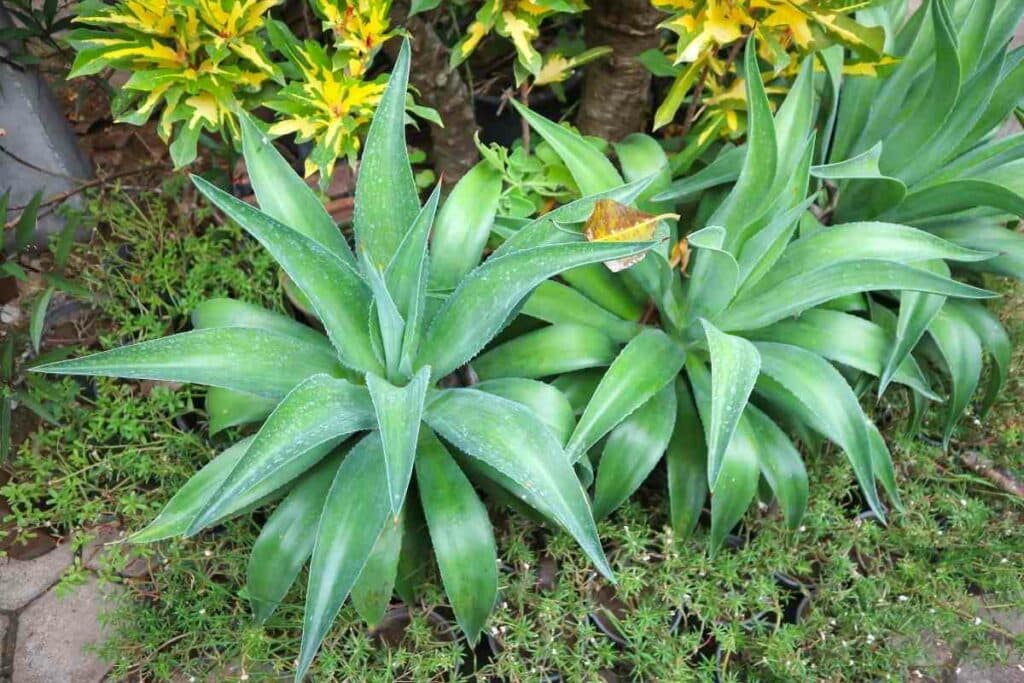
The blooms form seed pods and detach from the plant as time progresses. When this happens, the parent plants start dying.
It’s easy to grow agave from seed:
- Fill a shallow planter with a seed-starting mix.
- Then, scatter the seeds on top and expose the container to light to promote germination.
- Ensure the growing environment stays above 70oF and receives bright, indirect sunlight.
- The seedlings should be ready for transplanting within three weeks.
Transplanting Blue Agave Seedlings
If you can’t propagate seedlings or pups, it’s advisable to purchase bare-root plants.
They have several benefits over potted plants.
- First, you can inspect root health. You can tell if it has fungi or rot. The absence of soil also eliminates the risk of transferring eggs, larvae, and pathogens to your garden during transplantation.
- Secondly, transplanting a bare root plant allows you to transfer them to fresh, nutritious ground with proper drainage. As a result, these plants grow faster.
When transplanting a bare root plant, choose a site with well-draining soil and adequate sunlight.
Provide partial shade if your area experiences high temperatures above the recommended 70 degrees Fahrenheit.
Then, dig a hole as deep and wide as the plant’s roots.
Put the agave in the spot, fill it with soil, and water it sparingly. Provide an inch of water weekly until the plant is established.
Growing Blue Agave
Although blue agave is a reasonably hardy plant, below are the ideal conditions for growing it.
Soil and Location
Blue agave plants thrive in well-draining soil that receives adequate sunlight.
While this plant can grow in any soil type, it doesn’t do well in soggy conditions.
For this reason, it’s best to grow it on raised land to protect it against the cool air that accumulates in low areas.
Consider the future when choosing a planting site for your blue agave tree. Remember, it has a short lifespan and achieves an imposing stature.
It also has stiff, razor-sharp spines on its leaf edges, so ensure it’s far enough from pathways and other high-traffic areas.
Finally – Choose a location that will make it easy to uproot the plant once it dies.
Watering
After transplanting your blue agave, water it once weekly, applying an inch of water at every interval.
This should continue for a month if it doesn’t rain.
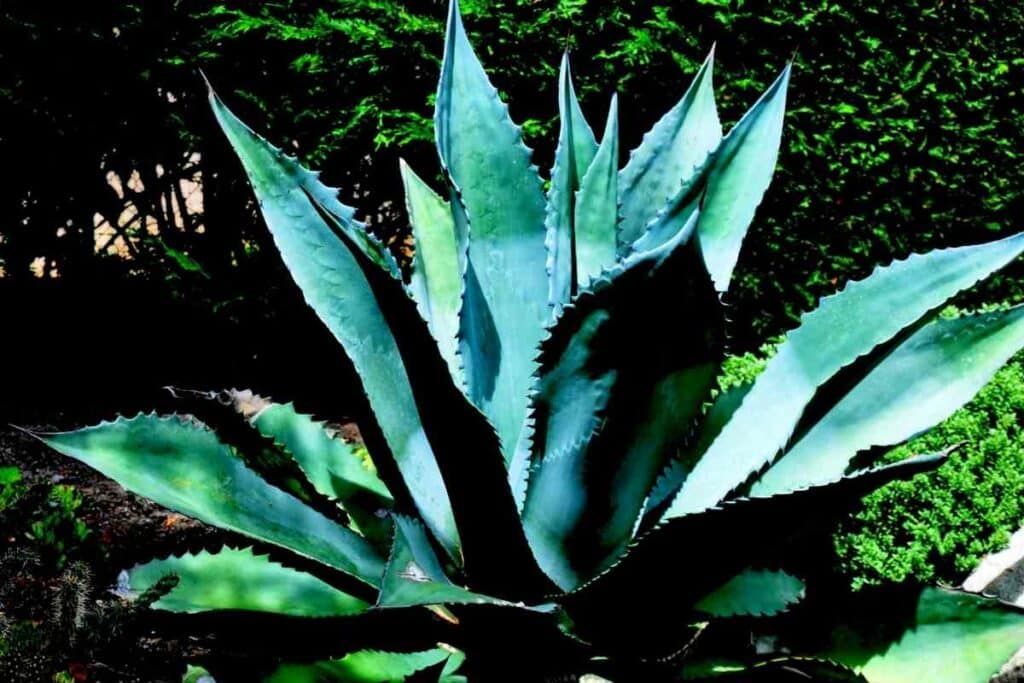
Afterward, water once or twice monthly if the drought persists. Be careful to avoid making the soil wet or soggy.
Never water blue agave during the rainy season. As mentioned earlier, these plants cannot tolerate damp soil.
Allow the ground to dry before watering. If you’re unsure how much water it needs, leave the plant unwatered because it uses water optimally.
Moreover, it has thick, fleshy leaves that store water for use during the dry season.
Fertilizer
Fertilizer application isn’t necessary when growing agave plants.
Feeding encourages rapid vegetative growth and flowering.

This is something you don’t want because the plant starts dying at the end of its first blooming cycle.
Nevertheless – You can feed it with a watered-down fertilizer dose to promote growth after extended droughts. However, be careful to avoid overfeeding.
Temperature and Humidity
Blue agave thrives in USDA growing zones 8 and 9.
It can withstand some cold but start deteriorating under freezing conditions.
Cover your blue agave plant with old blankets when it starts to freeze.
Don’t allow the plant to be exposed to temperatures below 28 degrees Fahrenheit for extended periods.
If the bleak conditions persist and the plant is small enough to move, gently uproot it and place it in a pot. Then, drag the container indoors until outside conditions improve.
Most agave trees prefer low-humidity conditions. High humidity increases the risk of crown rot.
How to Take Care of Blue Agave Plants
The most significant advantage of succulents like agave over other outdoor plants is the ease of care.
You don’t need an experienced gardener to grow a blue agave tree in your yard.
Here are some useful tips on taking care of agave plants.
Warmth
Agaves are native to deserts, meaning they thrive in hot and dry climates with little water for sustenance.
Please avoid overwatering these plants, as it causes crown rot. It’s essential to ensure the soil is dry before watering. Cover the plant with old clothing or move it indoors when it gets cold.
Light
Ensure your plant receives a minimum of 6 hours of sunlight daily.
The ideal temperature range is between 60 and 90 degrees Fahrenheit. Move it to a shaded area when it gets too hot.
Add Coarse Sand to Your Potting Mix
Agave needs well-draining soil to thrive.
Adding coarse sand to your potting mix improves drainage and reduces root rot risk.
When potting or planting your agave tree, give it enough room to grow. The hole or container should be twice as large as the plant.
The soil must be dry, ideally cactus soil. Ensure it has proper drainage.
Feeding it promotes growth and flowering, a cycle that always culminates in death.
Potting and Repotting Agave
Most agave species have shallow roots to absorb the little moisture they get from the soil’s top layer.
As such, you can grow them in shallow containers, provided it is stable enough to anchor the plant.
Remember, blue agaves can grow up to six feet tall, so the container must be wide and made using sturdy material to support such weight.
The best container for growing blue agave is an unglazed clay pot. Its porosity allows moisture to evaporate through its walls, reducing the risk of root rot.
If you can get this, ensure the container you use has adequate drainage holes.
Always use a well-draining potting suitable for succulents.
Water the container once weekly in summer and twice monthly in winter. Ensure the soil is dry before every watering session.
Over Time – Your plant will outgrow its current container and need another one. The best time to repot blue agave is in spring or summer. Use a bigger container and a fresh potting mix.
Don’t forget to inspect the roots for infections and potential pathogens before transferring the plant into a new container.
Overwintering
You must move agave plants indoors if you live outside their preferred hardiness zones.
Check the weather forecast – move the plant inside the house if they predict frosty conditions.
Keep the container next to your brightest window so that it receives sunlight. Then, when conditions improve, return it outside.
Common Pests Affecting Blue Agave
Generally, agaves are resistant to most pests and diseases affecting decorative plants.
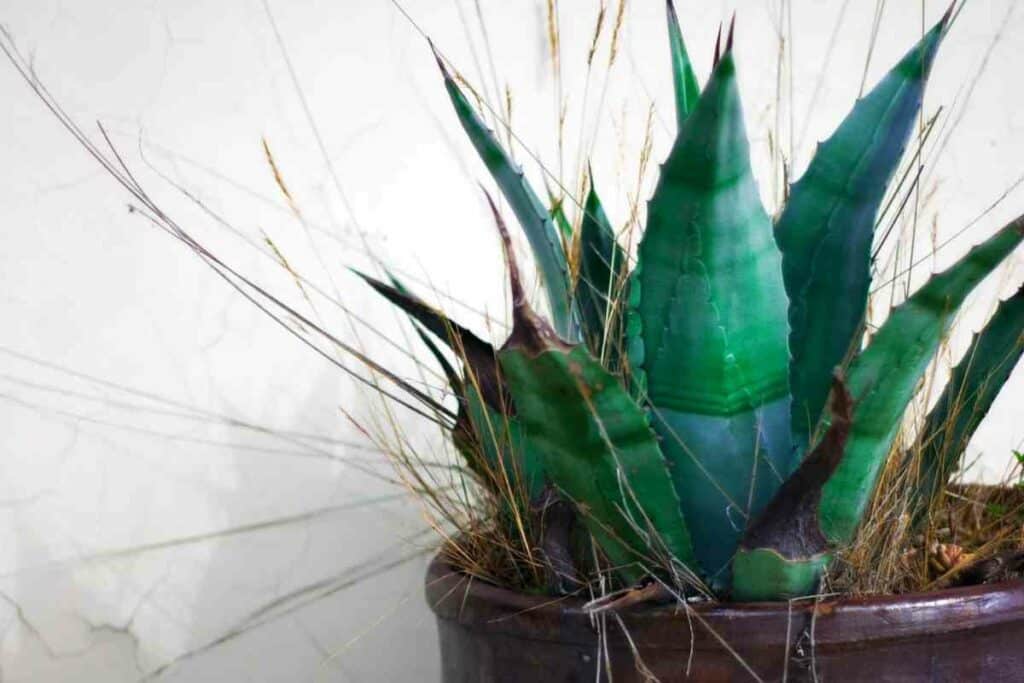
However, the agave snout weevil can penetrate the plant’s succulent leaves and lay eggs, causing the plant to collapse.
Unfortunately, such attacks often go unnoticed until it’s too late to restore the tree’s health.
The ideal way to work around this is to uproot the plant and burn it to prevent the pest from spreading.
Other Issues Affecting Agave Trees
Agaves rarely have problems when grown in optimal conditions.
However, here are some issues you’ll likely experience when growing agave.
Agave Crown Rot
The crown connects the roots to the leaves of the blue agave plant.
Ideally, the crown should always be above the soil to avoid moisture resulting from soil dampness.
However, moist soils aren’t the only cause of crown rot. Watering can also cause the condition, especially if the water falls into the rosette.
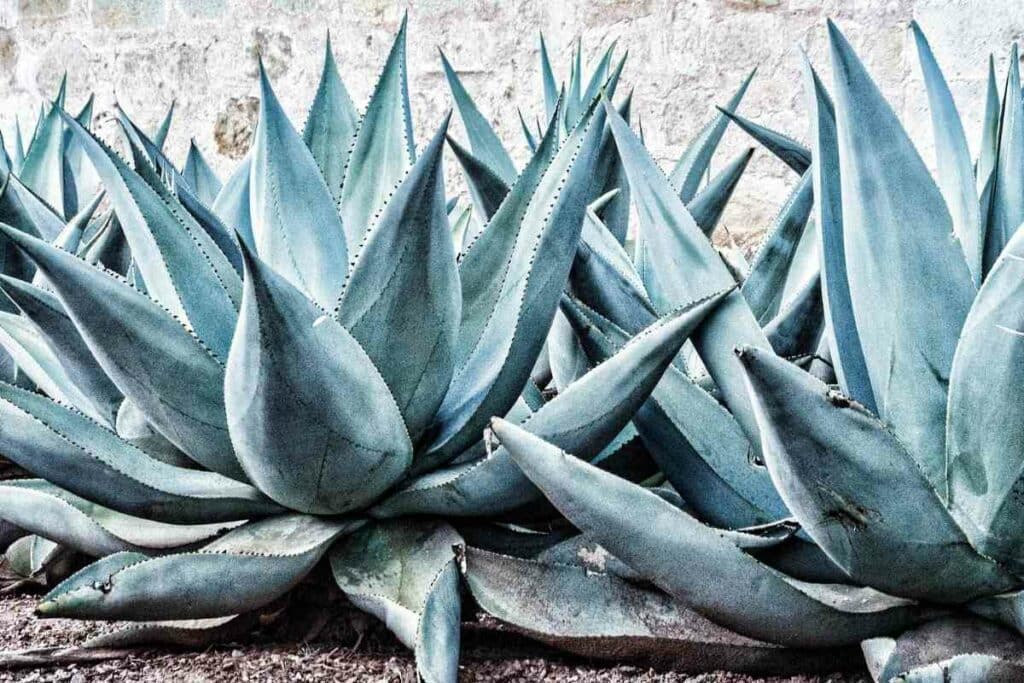
Sometimes, the agave snout weevil might cause crown rot that culminates in death.
Common crown rot symptoms include greying and black leaves, grey lesions, and an unending rot beginning at the rosette.
Over time, affected plants develop red-orange fungal growths containing fungal spores.
The spores spread the rot to nearby agaves when they explode.
Crown is preventable by inspecting the rosette regularly. Additionally, you can implement the following tips to lower the risk.
Caulotops Barberi
Caulotops Barberi are tiny bugs that cause massive damage to agave plants.
It isn’t easy to notice them because of their size.
These bugs tend to attack outdoor agaves more often than indoor plants.
Common symptoms of Caulotops Barberi infestation include:
- chewed leaves
- scabs
- speckles
- and spots
After some time, affected plants will experience stunted growth.
These bugs are more active in warm climatic regions in summer and early autumn. If you live in cold climates, your plants are less vulnerable to these pests.
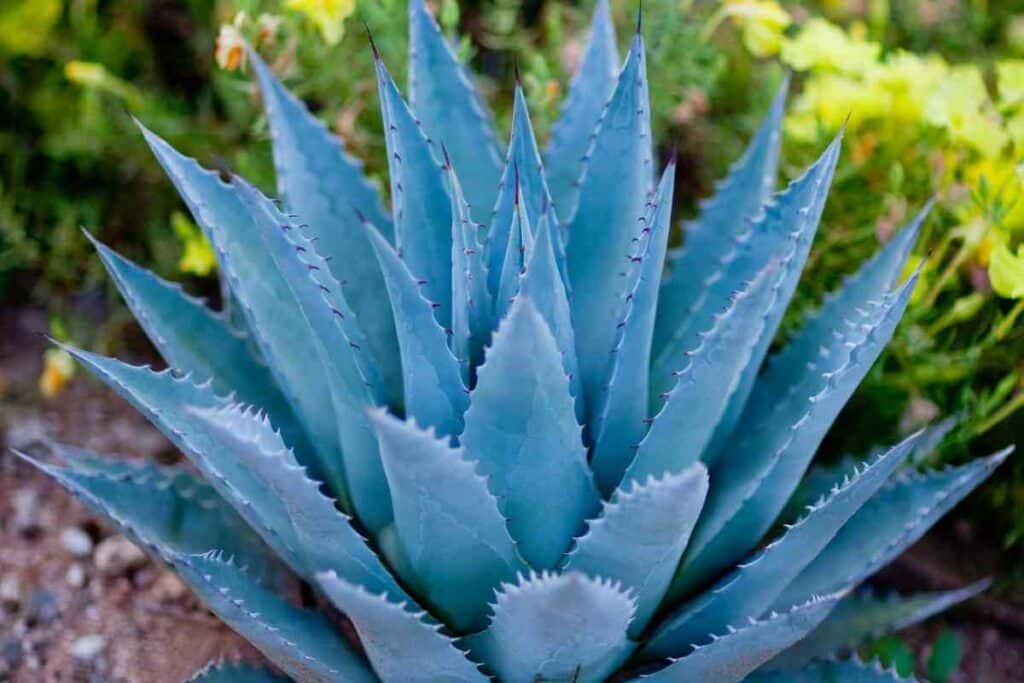
Since these tiny bugs aren’t visible to the naked eye, the best way to eliminate them is by spraying affected parts. If you notice any chewed leaves, spray the area with pesticides.
Sometimes, these bugs hide near the infected agave under debris or other plants.
For This Reason – It’s important to spray your tree’s surroundings and remove fallen leaves, branches, and other unwanted material.
Apply the pesticide during summer and early autumn, when Caulotops Barberi is most active.
Anthracnose
Fungal diseases affecting plants aren’t easy to detect and treat.
Anthracnose is such a condition that affects blue agave, especially in hot and humid climates.
Damp soil can also promote the growth and spread of fungal spores.
High humidity and temperatures, poor ventilation, and splashing water on the plant’s leaves are the leading causes of anthracnose.
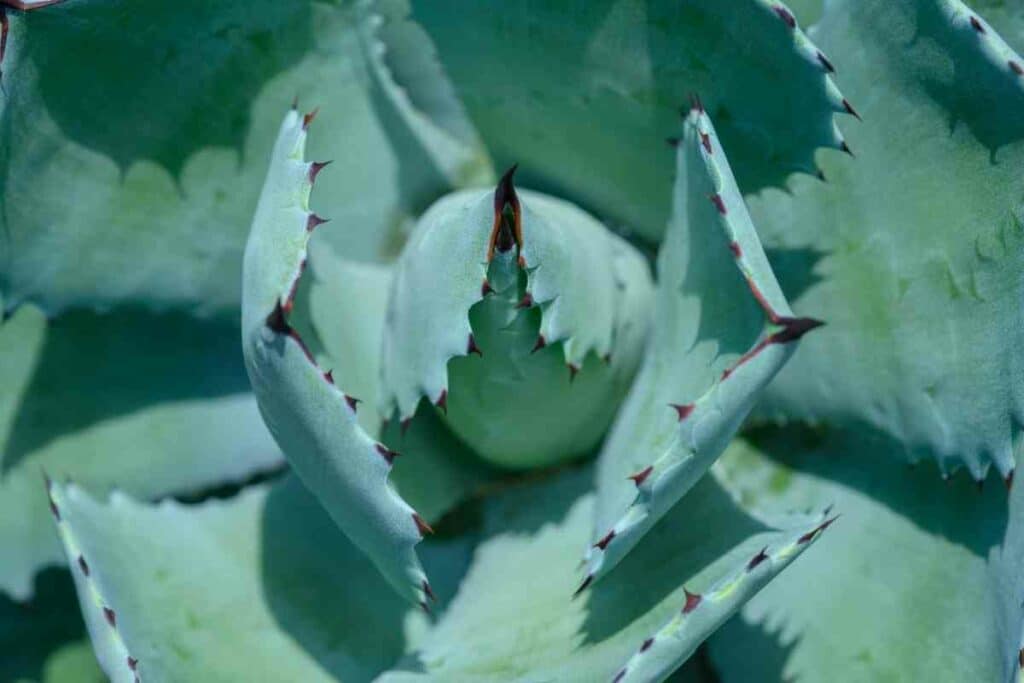
The first symptom of anthracnose is the appearance of sunken lesions on the rosette.
If left untreated, red-orange fungal growths emerge, later transforming into spores that spread the disease.
Although anthracnose cannot kill your agave plant, it hurts its visual appeal.
Sometimes, the infection might spread to less hardy plants and kill them. Here are a few tips for preventing anthracnose.
Wrapping Up
Blue agaves are beautiful, low-maintenance, and economically viable.
This is ideal if you want to add greenery that won’t disrupt your regular schedule!
But, remember, it dies once it flowers.
